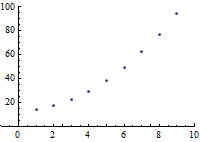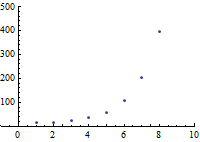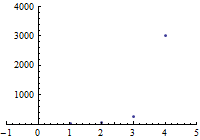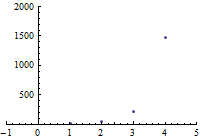
We use MathJax
Often a sequence will have neither a common difference nor a common ratio. Sometimes, though, the row of differences or ratios will itself have a pattern, and these can be examined in a second row of the diagram.
After examining the differences between consecutive terms, it may be observed that the differences of those differences is constant. Consider the sequence $14, 17, 22, 29, 38,\ldots$, for which we provide two rows of differences in the following diagram.
\begin{equation*} \begin{array}{ccccccccc} 14, & \phantom. & 17, & \phantom. & 22, & \phantom. & 29, & \phantom. & 38,\ldots \\ \phantom. & +3 & \phantom. & +5 & \phantom. & +7 & \phantom. & +9 & \phantom. \\ \phantom. & \phantom. & +2 & \phantom. & +2 & \phantom. & +2 & \phantom. & \phantom. \end{array} \end{equation*}The difference of the difference is called a second difference. Whenever a sequence has a common second difference, the sequence itself will have a quadratic explicit formula.
To obtain a recursive formula, we shall first look at a small diagram of the general case.
\begin{equation*} \begin{array}{ccccc} a_{n-2} & \phantom. & a_{n-1} & \phantom. & a_n \\ \phantom. & +b_{n-2} & \phantom. & +b_{n-1} & \phantom. \\ \phantom. & \phantom. & +c & \phantom. & \phantom. \end{array} \end{equation*}From this we see that $b_{n-1}=b_{n-2}+c$ and $a_{n-1}=a_{n-2}+b_{n-2}$. Therefore, we have:
\begin{align} a_n &= a_{n-1}+b_{n-1} \\ &= a_{n-1}+b_{n-2}+c \\ &= a_{n-1}+(a_{n-1}-a_{n-2})+c \\ &= 2a_{n-1}-a_{n-2}+c \end{align}For our specific example, we obtain the recursive formula $a_n = 2a_{n-1}-a_{n-2}+2, \quad a_1=14, \quad a_2=17$.
Now let us find the explicit formula of our specific example. Since we know that the formula will be quadratic, then it has the form $a_n=bn^2+cn+d$. This equation has three general coefficients, namely $b$, $c$, and $d$. Therefore we need three equations to determine them. So we use the first three terms of the sequence, and obtain the following system.
| $ \left\{ \begin{align} b(1^2)+c(1)+d &= 14 \\ b(2^2)+c(2)+d &= 17 \\ b(3^2)+c(3)+d &= 22 \end{align} \right. $ |
Solving this system of equations gives $b=1, c=0, d=13$, so the explicit formula is $a_n=n^2+13$.

Situations analogous to common second differences are quite similarly analyzed. Whenever the $n$th row of differences is common, the recursive formula will involve $n$ prior terms, and the explicit formula of the sequence will be a polynomial of degree $n$.
Consider the sequence $14, 17, 23, 35, 59, \ldots$ After some exploration, we should discover the pattern indicated in the following diagram.
\begin{equation*} \begin{array}{ccccccccc} 14, & \phantom. & 17, & \phantom. & 23, & \phantom. & 35, & \phantom. & 59,\ldots \\ \phantom. & +3 & \phantom. & +6 & \phantom. & +12 & \phantom. & +24 & \phantom. \\ \phantom. & \phantom. & \times 2 & \phantom. & \times 2 & \phantom. & \times 2 & \phantom. & \phantom. \end{array} \end{equation*}We see from the diagram that the ratios of the differences of consecutive terms of the sequence are common.
To obtain a recursive formula, we shall again look at a small diagram of the general case.
\begin{equation*} \begin{array}{ccccc} a_{n-2} & \phantom. & a_{n-1} & \phantom. & a_n \\ \phantom. & +b_{n-2} & \phantom. & +b_{n-1} & \phantom. \\ \phantom. & \phantom. & \times c & \phantom. & \phantom. \end{array} \end{equation*}From this we see that $b_{n-1}=b_{n-2}\times c$ and $a_{n-1}=a_{n-2}+b_{n-2}$. Therefore, we have:
\begin{align} a_n &= a_{n-1}+b_{n-1} \\ &= a_{n-1}+b_{n-2} \times c \\ &= a_{n-1}+(a_{n-1}-a_{n-2}) \times c \\ &= (c+1)a_{n-1}-c a_{n-2} \end{align}For our specific example, this gives the recursive formula $a_n=3a_{n-1}-2a_{n-2}, \quad a_1=14, \quad a_2=17$.
But there is another relationship hidden in this situation. Since the diagram of the general case also implies $c=\dfrac{b_{n-1}}{b_{n-2}} = \dfrac{a_n-a_{n-1}}{a_{n-1}-a_{n-2}}$, we can obtain $a_n-a_{n-1} = c(a_{n-1}-a_{n-2})$, which leads to $a_n-ca_{n-1} = a_{n-1}-ca_{n-2}$. Now this last equation implies that $a_n-ca_{n-1}$ must be a constant for every value of $n$. Therefore, calling this constant $d$, we have $a_n=(c+1)a_{n-1}-ca_{n-2}=ca_{n-1}+d$. And now we see that the case of common ratios of differences may always be written recursively using only one previous term, not two. For our specific example, we are now able to obtain the recursive formula $a_n=2a_{n-1}-11, \quad a_1 = 14$.
Turning now to the explicit formula, we begin by investigating how each term of the sequence arises from the patterns we have observed. This is illustrated in the following table.
| $n=1$ | $2$ | $3$ | $4$ | $5$ |
| $a_n=14$ | $17$ | $23$ | $35$ | $59$ |
| $14$ | $14+3$ | $14+3+2(3)$ | $14+3+2(3)+4(3)$ | $14+3+2(3)+4(3)+8(3)$ |
| $14$ | $14+1(3)$ | $14+3(3)$ | $14+7(3)$ | $14+15(3)$ |
| $14+(2^0-1)(3)$ | $14+(2^1-1)(3)$ | $14+(2^2-1)(3)$ | $14+(2^3-1)(3)$ | $14+(2^4-1)(3)$ |
The original diagram indicated that each term was built up by adding larger and larger multiples of 3. In the third row of this diagram, we examined just how many threes were required, and recognized in the fourth row that the number of threes followed a geometric sequence (namely 0, 1, 3, 7, 15). Thus, we recognized the exponential form of that parameter, written in the fifth row, from which we obtain the explicit formula $a_n=14+(2^{n-1}-1)(3)$, which after simplifying becomes $a_n=3(2^{n-1})+11$. In fact, it can be proven that whenever the ratios of the differences of consecutive terms of a sequence are common, then the explicit formula will be the sum of an exponential term and a constant term.

One frequent application of this type of sequence is a monthly payment on a loan. The interest rate will affect the coefficient of the exponential term, while the size of the payment is the (negative) constant term.
Consider the sequence $14, 42, 252, 3024, 72576, \ldots$ The patterns in this sequence are indicated in the following diagram.
\begin{equation*} \begin{array}{ccccccccc} 14, & \phantom. & 42, & \phantom. & 252, & \phantom. & 3024, & \phantom. & 72576,\ldots \\ \phantom. & \times 3 & \phantom. & \times 6 & \phantom. & \times 12 & \phantom. & \times 24 & \phantom. \\ \phantom. & \phantom. & \times 2 & \phantom. & \times 2 & \phantom. & \times 2 & \phantom. & \phantom. \end{array} \end{equation*}We observe that the ratios of the ratios are common.
The recursive formula can be obtained by analyzing a general pattern as we did in the previous two examples. From such an analysis, it can be determined that the recursive formula for this sequence is $a_n = \dfrac{2{a_{n-1}}^2}{a_{n-2}}, \quad a_1=14, \quad a_2=42$.
The explicit formula can be obtained by an analysis similar to the analysis in the preceding example. From this, we find the explicit formula of this sequence is $a_n = 14(3^{n-1})(2^{\frac{(n-1)(n-2)}{2}})$. In fact, sequences having common second ratios will always have explicit formulas that involve a quadratic expression in the exponent.

Consider the sequence $14, 42, 210, 1470, 13230, \ldots$ The following diagram gives the patterns observed in this sequence.
\begin{equation*} \begin{array}{ccccccccc} 14, & \phantom. & 42, & \phantom. & 210, & \phantom. & 1470, & \phantom. & 13230,\ldots \\ \phantom. & \times 3 & \phantom. & \times 5 & \phantom. & \times 7 & \phantom. & \times 9 & \phantom. \\ \phantom. & \phantom. & +2 & \phantom. & +2 & \phantom. & +2 & \phantom. & \phantom. \end{array} \end{equation*}Following the pattern of the previous examples, we find that the recursive formula for this sequence is $a_n=\dfrac{{a_{n-1}}^2}{a_{n-2}}+2a_{n-1}, \quad a_1=14, \quad a_2=42$.
To generate the explicit formula, we note the factorial-like pattern that occurs in the second row of the diagram above. This leads to the following table.
| $n=1$ | $2$ | $3$ | $4$ | $5$ |
| $a_n=14$ | $42$ | $210$ | $1470$ | $13230$ |
| $14$ | $14\times 3$ | $14\times 3\times 5$ | $14\times 3\times 5\times 7$ | $14\times 3\times 5\times 7\times 9$ |
| $14$ | $14\times\dfrac{3!}{2}$ | $14\times\dfrac{5!}{2\times 4}$ | $14\times\dfrac{7!}{2\times 4\times 6}$ | $14\times\dfrac{9!}{2\times 4\times 6\times 8}$ |
| $14\times\dfrac{(2\times 0+1)!}{2^0 \times 0!}$ | $14\times\dfrac{(2\times 1+1)!}{2^1 \times 1!}$ | $14\times\dfrac{(2\times 2+1)!}{2^2 \times 2!}$ | $14\times\dfrac{(2\times 3+1)!}{2^3 \times 3!}$ | $14\times\dfrac{(2\times 4+1)!}{2^4 \times 4!}$ |
Therefore, the explicit formula for the sequence is $a_n=\dfrac{14(2n-1)!}{2^{n-1}(n-1)!}$. In general, the explicit formula of this case may also contain gamma functions, which are a generalization of factorials to non-integer values.
